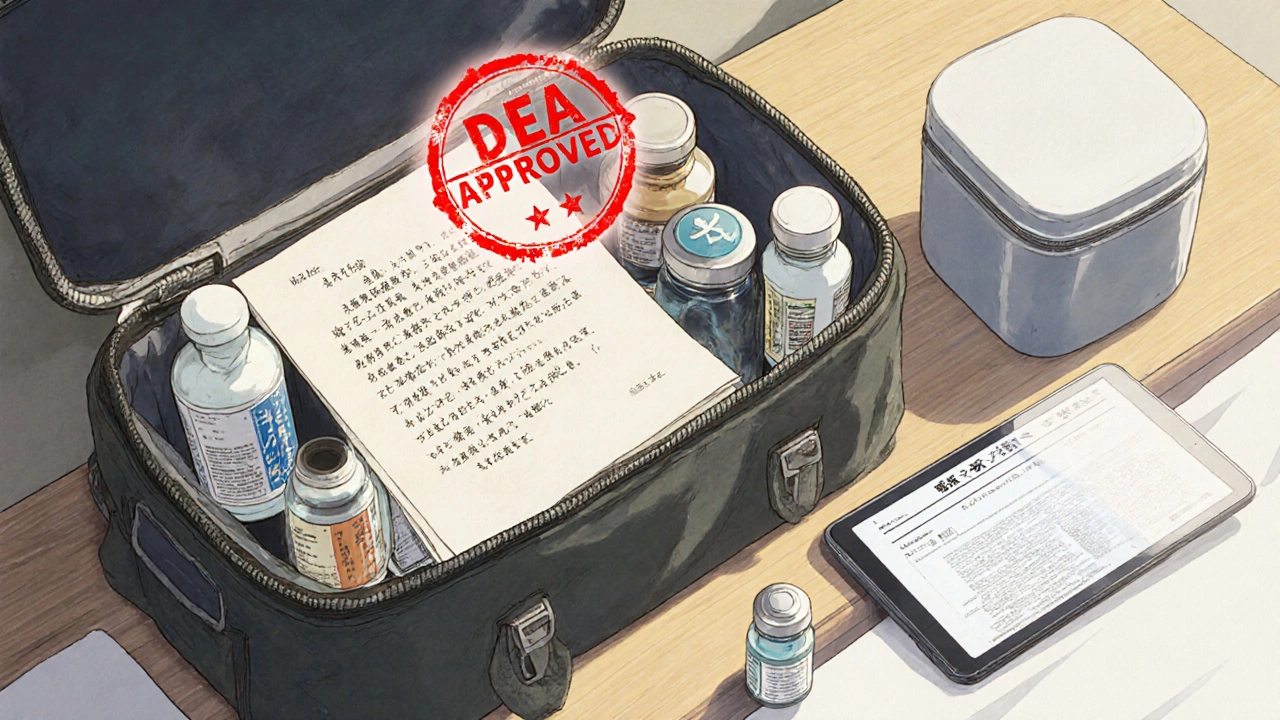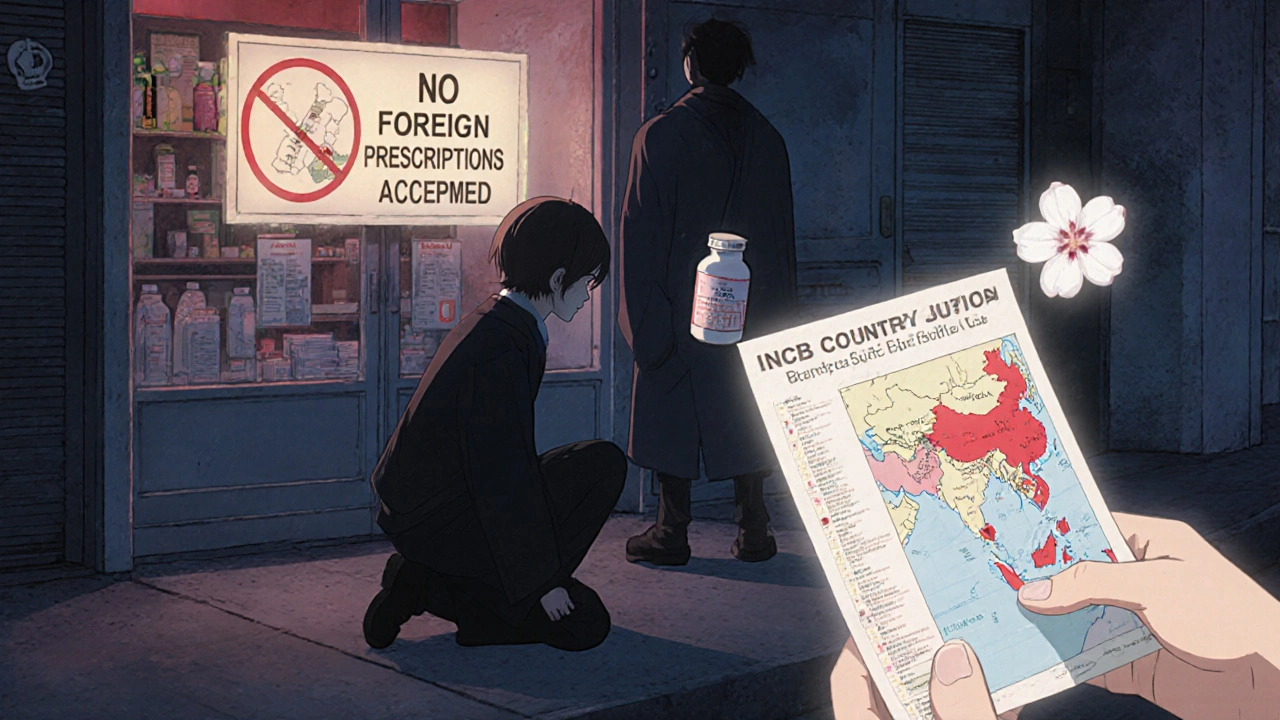Border and Customs Rules for Bringing Medications Internationally in 2025

Bringing your medications across borders isn’t just about packing a pill bottle in your suitcase. In 2025, what’s legal in New Zealand could get you arrested in Thailand, detained at U.S. customs, or have your insulin seized in Dubai. Every year, thousands of travelers run into trouble because they assume their prescriptions are universal. They’re not. And the rules just got tighter.
What You Can and Can’t Bring Across Borders
The U.S. allows foreign nationals to bring in up to a 90-day supply of prescription medication for personal use - as long as it’s for a condition you’re actually treating. That’s the FDA’s rule. But if your medication contains a controlled substance - like oxycodone, Adderall, Xanax, or even certain sleep aids - you need more than just a prescription. You need prior approval from the DEA. In 2024, the DEA approved 78.3% of the 12,457 personal import requests it received. That means nearly one in five people were denied, even with a valid prescription.
Canada is more lenient: you can bring up to a 180-day supply under their Special Access Programme. The European Union generally sticks to the 90-day limit, but countries like Germany and France may ask for extra paperwork. Japan and Singapore are among the strictest. Even common medications like pseudoephedrine (found in cold pills) or codeine (in some cough syrups) are banned or tightly controlled there.
And don’t assume your country’s rules apply elsewhere. A medication you take daily in Auckland might be classified as a narcotic in Malaysia, a Schedule I drug in Saudi Arabia, or illegal outright in the UAE. The International Narcotics Control Board (INCB) lists 147 commonly restricted medications - including antidepressants, ADHD meds, and anxiety drugs - that trigger red flags in over 80 countries.
Documentation: The Only Thing That Saves You
Having a prescription isn’t enough. You need the right documentation - and in the right format.
- Original bottles with pharmacy labels: This is non-negotiable. The label must show your name, the drug name, dosage, prescribing doctor, and pharmacy info. If you transfer pills to a pill organizer, you’re risking seizure. Carry the original bottles.
- Doctor’s letter on letterhead: This should list your condition, the generic name of each medication, dosage, and why you need it. It must be signed and dated. Sixty-eight countries require this. It’s not optional.
- Translated documents: If you’re traveling to a non-English-speaking country, get your prescription and doctor’s letter translated. Some countries, like Japan and South Korea, require official translations from embassies or certified translators. A Google Translate printout won’t cut it.
Pro tip: Carry a digital copy of everything - photos of your prescription labels, scanned letters, even a PDF of the INCB’s country-specific list. If your luggage is delayed or confiscated, you’ll need proof fast.
The DEA, TSA, and U.S. Customs: What Changed in 2025
On August 29, 2025, the U.S. suspended the $800 de minimis threshold for all imported medications. That means even a single bottle of pills mailed from overseas now triggers customs inspection, potential duties, and delays. Before this change, 3.4-day average processing time for medication shipments jumped to 5.7 days. People who ordered refills online now wait weeks.
For travelers flying into the U.S., the TSA still allows unlimited quantities of prescription meds - pills, liquids, creams - but liquids over 3.4 ounces (100ml) get screened separately. You don’t need to declare them at security unless asked. But if you’re carrying controlled substances, be ready to show your DEA authorization or doctor’s letter.
At U.S. Customs, agents are trained to look for signs of diversion. If you’re carrying 10 bottles of Adderall or 3 months’ worth of oxycodone, you’ll be questioned. It’s not about quantity alone - it’s about context. Are you traveling alone? Is the medication for a chronic condition? Do you have the paperwork? Answering honestly and having your documents ready can prevent detention.

What Happens When Things Go Wrong
People get arrested for carrying medications abroad. In 2024, the CDC logged 1,847 cases of travelers needing emergency help with medications. Over half involved controlled substances. In Thailand, a woman was jailed for 18 months for carrying Xanax in her purse. In Singapore, a man was fined $10,000 for bringing in a bottle of codeine cough syrup.
Common mistakes:
- Bringing ADHD meds like Adderall to Asia - 42% of travelers report issues there.
- Using pill organizers instead of original bottles - this is the #1 reason medications get confiscated.
- Assuming a doctor’s note in English is enough - in 78 countries, you need a translation.
- Not checking the status of cannabis-derived meds - even CBD oil is illegal in 161 countries.
Positive outcomes? They happen when people prepare. One traveler from California told Trustpilot she sailed through Japanese customs because she carried her prescription in English, a Japanese translation from her embassy, and the original labeled bottles. That’s the gold standard.
Special Cases: Insulin, Pumps, and Medical Devices
If you use an insulin pump, CGM, or other medical device, you’re not just carrying medication - you’re carrying life-support equipment. The TSA has a program called TSA Cares that offers help with screening. Call 1-855-787-2227 at least 72 hours before your flight. You can request a private screening, a specialist to assist you, or even a visual inspection instead of X-ray for your device.
Always carry your device with you - never in checked luggage. Bring a doctor’s letter explaining its purpose. Some countries, like Australia and the UK, have specific forms you can download from their health departments. Fill them out in advance.
For insulin: Keep it cool. Carry a small cooler with ice packs if you’re on a long flight. Some airlines allow you to store it in the galley. Ask ahead.

How to Prepare: A 6-Week Checklist
Don’t wait until the day before your flight. Start early. Here’s what to do:
- Week 6-8: Check the INCB’s country-specific database for your destination. Look up every medication you’re taking. Note any restrictions.
- Week 5: Contact your doctor. Ask for a letter on official letterhead listing generic names, dosages, and medical necessity. Get it signed and dated.
- Week 4: If your destination requires translations, contact their embassy or a certified translator. Don’t use online tools.
- Week 3: If you’re carrying controlled substances, apply for DEA authorization if traveling to the U.S. or other countries that require it.
- Week 2: Pack original bottles. Label each one. Take photos of labels and documents. Save them on your phone and email them to yourself.
- Week 1: Call your airline. Ask about their policy on medical devices and medications. Confirm you can carry your insulin or pump on board.
What to Do If Your Medication Is Confiscated
If customs takes your meds, don’t argue. Stay calm. Ask for a receipt. Get the name and badge number of the officer. Contact your country’s embassy immediately. They can’t get your meds back, but they can help you find local alternatives or connect you with a doctor.
Some countries, like Canada and the UK, have emergency medication programs for travelers. In Japan, pharmacies can dispense certain medications with a foreign prescription - if you have a certified translation. Always carry the contact info for your embassy.
Future Rules: What’s Coming
By 2026, all imported prescription drugs entering the U.S. must have electronic tracking codes under the DSCSA. This won’t affect personal travelers much - but it will make it harder to order meds online from overseas pharmacies.
By 2027, 45% of countries plan to tighten controls on synthetic opioids and mental health medications. That means even common SSRIs and benzodiazepines could face new restrictions. The EU is moving toward a 60-day limit for personal imports, and many Asian countries are cracking down on stimulants.
The trend is clear: borders are getting harder, paperwork is getting longer, and the penalties are getting steeper. The good news? If you prepare, you’ll be fine.
Can I bring my prescription medication in a pill organizer?
No. Customs officials in many countries require medications to be in their original pharmacy-labeled containers. If you transfer pills to a pill organizer, you risk having them confiscated. Always carry the original bottles. If you need to use a pill organizer for convenience, keep the original labeled bottles in your carry-on as proof.
Do I need a letter from my doctor for every medication?
Not for every single pill, but yes for any controlled substance - and strongly recommended for all prescription meds. A single letter listing all your medications, their generic names, dosages, and your medical condition is sufficient. It must be on your doctor’s letterhead, signed, and dated. Many countries require this even if you have a prescription.
Are over-the-counter medications like ibuprofen or allergy pills restricted?
Most are fine, but not all. In the UAE, pseudoephedrine (found in some cold and allergy meds) is banned. In Singapore, diphenhydramine (Benadryl) requires a prescription. Always check your destination’s rules - even common OTC drugs can be flagged. When in doubt, bring the original packaging and a note from your doctor.
Can I mail my medication ahead of time?
It’s risky. Since August 29, 2025, the U.S. and many other countries no longer allow duty-free entry for any medication shipments, regardless of value. All packages are subject to customs inspection, delays, and possible seizure. It’s safer to carry what you need with you. If you must mail something, use a courier with customs clearance expertise and declare everything accurately.
What if my medication isn’t available in the country I’m visiting?
Contact your country’s embassy before you travel. They often have lists of local pharmacies that can fill foreign prescriptions. You may need to see a local doctor to get a new prescription. Bring your original prescription and doctor’s letter - they’ll help the local doctor understand your needs. Never assume your medication will be available. Always bring extra.
